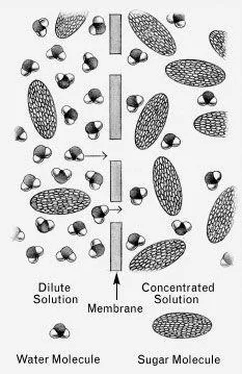Marlene Parrish - What Einstein Told His Cook 2
Здесь есть возможность читать онлайн «Marlene Parrish - What Einstein Told His Cook 2» весь текст электронной книги совершенно бесплатно (целиком полную версию без сокращений). В некоторых случаях можно слушать аудио, скачать через торрент в формате fb2 и присутствует краткое содержание. Год выпуска: 0101, Издательство: W. W. Norton & Company, Жанр: Кулинария, на английском языке. Описание произведения, (предисловие) а так же отзывы посетителей доступны на портале библиотеки ЛибКат.
- Название:What Einstein Told His Cook 2
- Автор:
- Издательство:W. W. Norton & Company
- Жанр:
- Год:0101
- ISBN:нет данных
- Рейтинг книги:4 / 5. Голосов: 1
-
Избранное:Добавить в избранное
- Отзывы:
-
Ваша оценка:
- 80
- 1
- 2
- 3
- 4
- 5
What Einstein Told His Cook 2: краткое содержание, описание и аннотация
Предлагаем к чтению аннотацию, описание, краткое содержание или предисловие (зависит от того, что написал сам автор книги «What Einstein Told His Cook 2»). Если вы не нашли необходимую информацию о книге — напишите в комментариях, мы постараемся отыскать её.
What Einstein Told His Cook 2 — читать онлайн бесплатно полную книгу (весь текст) целиком
Ниже представлен текст книги, разбитый по страницам. Система сохранения места последней прочитанной страницы, позволяет с удобством читать онлайн бесплатно книгу «What Einstein Told His Cook 2», без необходимости каждый раз заново искать на чём Вы остановились. Поставьте закладку, и сможете в любой момент перейти на страницу, на которой закончили чтение.
Интервал:
Закладка:
When the ships of the Dutch East India Company brought tea from China to Europe in the seventeenth century, the Dutch changed the Chinese dialectical word t’e to tee . The English then changed the spelling to tea . Back in Asia, where tea was being transported by overland routes, some regions along the way called it ch’a (the Mandarin name) or chai . Today, if your ancestors first obtained their tea by overland trade, you probably call it chai; if it first arrived by sea, you call it tea. Or as Paul Revere might have put it: “Chai if by land and tea if by sea.”
One Indian version of chai is a sweet and spicy milk tea that has become increasingly popular throughout the world. Chai is so mainstream in the United States today that it can be found not only on the menu at Starbucks but also in aseptic cartons in many supermarkets.
2 cups water
2 teaspoons loose black tea or 2 tea bags
1 small cinnamon stick, about 2 inches long
1 cardamom pod, lightly crushed
1 small whole clove
1 slice fresh ginger, the size of a nickel, peeled
2 cups whole milk, soy milk, or rice milk
Honey, to taste
1.Place all the ingredients except the honey in a saucepan and slowly bring to a boil. Swirl the mixture around for about 3 minutes, or until it reaches the desired strength and the spices release their aromas.
2.Strain into teacups and add honey to taste. Chai tastes best when very strong and very sweet. Some people prefer to add the milk after the tea has been strained and sweetened.
MAKES 4 SERVINGS
IT’S BETTER BEING GREEN
There’s a lot of talk about green tea these days.
But isn’t all tea green to begin with? Are there other tea plants with other-colored leaves, or are other teas picked after the green is gone? I bought some green tea the other day and it looks pretty black to me, not green at all.
All tea comes from the same, one-and-only tea plant, Camellia sinensis , whose leaves certainly were chlorophyll-green on the living plant. But based upon how the leaves are processed, there are three types of tea: green, which is consumed mostly in the Far East; black, the favorite of the British and other Westerners; and oolong (“black dragon” in Chinese dialect), which is intermediate in flavor between the green and the black.
Beyond this, there are a bewildering number of names for dozens of kinds of tea based on their places of origin, the sizes of their leaves, or added flavorings such as jasmine, bergamot (in Earl Grey), and orange blossoms.
In all cases, the leaves are first plucked from the plant and encouraged to wither and lose moisture, usually by means of hot air or, more traditionally, by being exposed to the sun. After that, the green, black, and oolong teas take different paths.
Leaves destined to be sold as green tea are blasted with steam or roasted on iron pans in order to deactivate enzymes in the plant cells (see “What’s an enzyme?” on chapter 1) and prevent the so-called fermentation that black and oolong teas undergo. The leaves for green tea are dried until the moisture content is about 3 percent, and then are crushed or powdered.
In the case of black and oolong teas, the withered leaves are rolled in a large rolling machine that twists them and breaks open their cells, simultaneously exposing the insides to oxygen and releasing an enzyme (polyphenol oxidase) that oxidizes the polyphenal tannins in the leaves. Among the products of the oxidation reactions are orange, red, and yellow compounds called theaflavins and thearubigins, which give the tea briskness and color.
This oxidation process is almost universally but mistakenly referred to as fermentation, but yeasts and bacteria have nothing to do with it; it’s purely a chemical, not a biological, process. The difference between oolong and black tea lies in how long the oxidation process is permitted to continue: a few hours for black tea and only about half as long for oolong. The time and temperature must be strictly controlled to produce a tea of superior flavor. The oxidation process is stopped by deactivating the enabling enzyme with hot air, as in making green tea. That’s why green tea brews a lighter-colored beverage than black tea: fewer theaflavins and thearubigins.
The ultimate flavor properties of a tea will depend not only on how the leaves are processed but on how and where the bush grows, the local climate, the season during which the leaves are picked, and the position of the leaves on the plant.
By the way, if you expect me to expound on the reputed health benefits of drinking green tea, I must disappoint you. All I know is what I read, and my take on what I read is that the outlook is encouraging but that the jury has not yet come to a unanimous verdict. Presumably, any healthful benefits of green tea must have something to do with the fact that its polyphenols have not been oxidized, and polyphenols are antioxidants: they gobble up age-and illness-causing free radicals in the body.
I drink it every morning instead of coffee.
Sidebar Science: What’s an enzyme?
ENZYMES HAVEbeen misunderstood almost as much as instruction manuals for VCRs. Everyone know that enzymes play essential roles in all living things, but what exactly are they?
Are they alive, like bacteria? No. They’re chemicals, almost all of them proteins, that accelerate the complex chemical reactions essential to living things, both plant and animal. In other words, they are catalysts , substances that help chemical reactions go faster but are not used up in the process. Without enzymes, the chemistry of life would be impossibly slow, if it proceeded at all.
An enzyme molecule does its catalyzing job when a specific part of it, called its active site , reacts with a specific chemical, called its substrate , enabling that substrate to take part in vital chemical processes thousands or millions of times faster than it ordinarily would. The molecules of each type of enzyme have a unique shape that can react with only one specific substrate, thereby catalyzing only one specific chemical reaction. There is a unique enzyme for each of the hundreds of chemical reactions essential to the lives of all plants and animals.
For example, the dissolving of waste carbon dioxide from our bodily tissues into our bloodstreams and the “undissolving” of it back to gas for exhalation from our lungs are absolutely essential life processes. But if it weren’t for the enzyme carbonic anhydrase , these processes would take place so slowly that we couldn’t survive. Carbonic anhydrase makes the processes happen ten million times faster. Each carbonic anhydrase molecule can perform its speed-up act on a million carbon dioxide molecules per second.
An enzyme is named by tacking the suffix - ase onto a brief description of what it does. The tea enzyme is named polyphenol oxidase because it oxidizes polyphenols. If there were such a thing as an enzyme that speeds up the glazing of pottery, it might be called a vase glazease.
LITMUS TEA
Why does my tea turn a lighter color when I add lemon? On the other hand, my grandmother used to add a pinch of baking soda to her tea, and it turned as dark as brandy. What did she know that I don’t know?
Are you sure it wasn’t brandy? Might Granny perhaps have been engaging in a bit of teacup tippling?
But okay, I’ll take her word for it. Here’s what was going on in both your cups.
Читать дальшеИнтервал:
Закладка:
Похожие книги на «What Einstein Told His Cook 2»
Представляем Вашему вниманию похожие книги на «What Einstein Told His Cook 2» списком для выбора. Мы отобрали схожую по названию и смыслу литературу в надежде предоставить читателям больше вариантов отыскать новые, интересные, ещё непрочитанные произведения.
Обсуждение, отзывы о книге «What Einstein Told His Cook 2» и просто собственные мнения читателей. Оставьте ваши комментарии, напишите, что Вы думаете о произведении, его смысле или главных героях. Укажите что конкретно понравилось, а что нет, и почему Вы так считаете.












